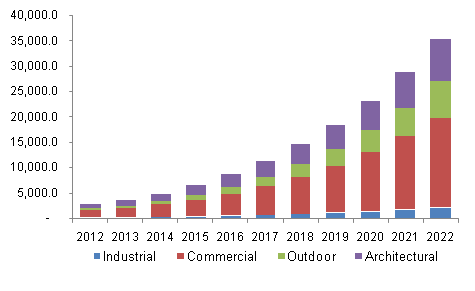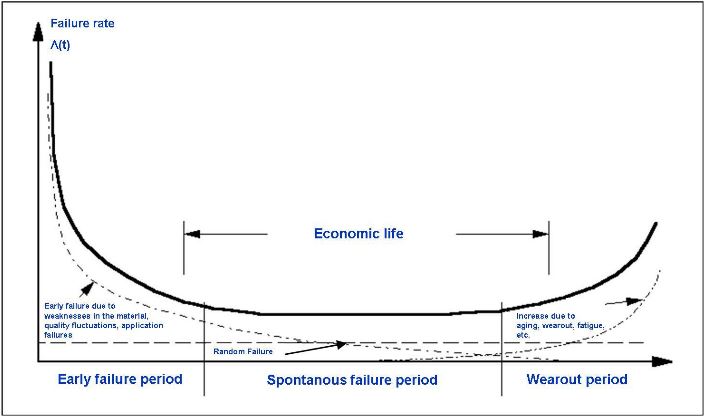LEDs are the longest lasting and most energy efficient lighting products on the market. They have made a significant impact on the American and global economy in a short period of time, due to tremendous growth and market penetration. Rapid growth, however, is often saddled with a number of issues. For a time, two major problems encumbered the LED market: underachieving product lifespans and failure rates. As a result, complaints about LEDs burning out, flickering, or not functioning as advertised was a higher than normal occurrence. Inexperienced electrical contractors hired to install LED systems irritated the issue further. In this article, we explore the operational difficulties LED manufacturing has encountered since their burst into the mainstream market in 2012 and the steps commercial and industrial customers should take to avoid complications and maximize LED investment dollars.
By the Numbers
LED lamps started to hit the markets around 2008 and were praised for their ability to last longer and save considerably more energy than incandescent and compact fluorescent (CFL) technologies. LEDs, however, were expensive, and despite their obvious environmental benefits, few considered their purchase a worthwhile investment. By 2012, consumer interest had increased and technology had advanced to the point where LEDs had dropped to around $40 per bulb. At the same time, the U.S. was phasing out incandescent bulbs and introducing new lighting standards, all while energy efficiency was becoming a rising socioeconomic force in America. The combination of both socioeconomic and government forces would eventually lead to the energy efficiency boom.
Here’s what that boom looked like around 2012. From 2012 to 2014, 78 million LEDs were installed, a six-fold growth increase. For each year between between 2012 and 2014, LED market penetration doubled, rising to 33% market penetration by 2015. Its exponential growth has helped prices drop by more than 85% since 2008. The chart below depicts the growth of the North American industrial and commercial LED lighting market share from 2012-2022 (USD Million).

Image source: Grandview Research
Efficiency Over Design
LED lighting was developed to replace and outperform CFLs in terms of energy efficiency and lifespan. However, an influx of demand and a lack of strict defect testing caused repercussions. “As the LED industry has embarked on an unprecedented scale-up in manufacturing capacity worldwide, it is clear that manufacturing techniques that were suitable for low-volume production are no longer adequate.” This led to two serious operations management issues: underachieving product lifespan and failure rates. In June 2011, in an attempt to educate and rectify the issue, Energy.gov developed and published its LED Luminaire Lifetime: Recommendations for Testing and Reporting, which investigated the issue of LED reliability, lifetime, and root causes of failures. Besides normal end of life failures, two major research themes identified were design flaws and manufacturing defects.
The diagram below recognizes that LEDs are not exclusive to initial high failure rates. The bathtub curve is a design used in engineering to depict failure rates at different stages during product lifetime. If products are untested before coming to market, however, customers will experience a higher failure rate. Conducting rigorous testing with best practices is critical to ensure a product’s failure rates falls within normal defect variation.

Image source: OSRAM Opto Semiconductors
Significant Industry Improvements
Many advancements have been implemented into LED manufacturing processes that have rectified many of the initial issues. Many products on the market are now DesignLights Consortium (DLC) certified, a non-profit devoted to promote “quality, performance, and energy efficient commercial sector lighting solutions.” In 2013, to test the quality of LEDs on the market, the U.S. Department of Energy (DOE) administered a test using 200 Philips lamps to test product reliability. That results indicated that, “. . . there have been no failures, lumen depreciation is negligible, and average chromaticity shift is less than .002,” whereby chromaticity refers to the hue and color of the lamp. Today, the world’s top lighting manufacturers are incorporating Six Sigma practices, a disciplined approach for eliminating defects in manufacturing operations. This does not mean there are now no unscrupulous practices in LED manufacturing, in either the U.S. or worldwide. Customers that purchase discounted LEDs or from a less than trustworthy manufacturer are more likely to suffer from product inconsistencies and failures.
Maximizing Your LED Investment
Lighting is important for businesses of all types, for showcasing or drawing attention to goods; creating the right ambiance for patrons; ensuring safety; or keeping employees, attentive, alert, and productive. For commercial and industrial customers, the best way to maximize your LED investment is to work with an energy services company (ESCO) that knows the ins and outs of the electrical, mechanical, and lighting energy efficiency industry. ESCOs work with local utility companies and are mandated to source products that are DLC certified. ESCOs also have extensive experience with electrical contractors, ensuring only the most experienced electrical contractors are those performing installations. A proper installation is equally as important as ensuring LEDs are procured from reputable sources. Well-tested, highly-reliable, and quality LED products can still fail due to poorly trained or incompetent electrical contractors who install them improperly.
Bottom Line
A combination of government regulations, socioeconomic forces, and rapid growth led to a boom in the LED market, but was met with product quality and lifespan issues. Over the years, top manufacturers have begun incorporating highly stringent practices to ensure product failure rates fall within a normal defect variation.
The bottom line is simple: Caveat emptor. Before investing in an LED lighting retrofit, understand from where your LEDs are sourced and who is installing them. Working with an ESCO is one of the easiest solutions for commercial and industrial businesses to ensure the maximization of your LED investment.




